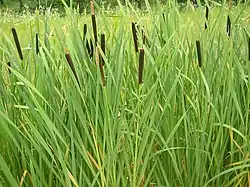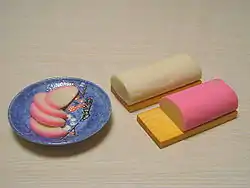蒲鉾
Japanese
| Kanji in this term | |
|---|---|
| 蒲 | 鉾 |
| かま Jinmeiyō |
ほこ > ぼこ Hyōgaiji |
| kun’yomi | |
Etymology
Compound of 蒲 (kama, “cattail, bulrush”) + 鉾 (hoko, “spear”). The cattail plant sense is from the way the seed spike resembles a spear. The food-related sense comes from the way the fishcake would often be shaped into a tube on a skewer for roasting, resembling a cattail seed spike in shape and sometimes color. The hoko changes to boko as an instance of rendaku (連濁).. [1][2][3]
Noun
蒲鉾 • (kamaboko)
Usage notes
Generally written in hiragana due to the high number of strokes and rarity of the characters used in the kanji spelling.
Derived terms
Derived terms
- 蒲鉾芋 (kamaboko imo): grated 山芋 (yamaimo), wheat flour, and arrowroot mixed, placed on a board, steamed, and made to look like kamaboko
- 蒲鉾形 (kamabokogata): a domed shape like a kamaboko loaf placed on a board
- 蒲鉾小屋 (kamabokogoya): a rough hut shaped like a kamaboko loaf, made of bent bamboo and covered in rushes
- 蒲鉾箍 (kamaboko taga): a brass or copper hoop such as for a barrel or 湯桶 (yutō) that is wide in the middle and narrow at the edges, similar in shape to a kamaboko loaf
- 蒲鉾豆腐 (kamabokodōfu): tofu mixed with walnuts, placed on a board, steamed, and made to look like kamaboko
- 蒲鉾味噌 (kamaboko miso): surimi mixed with white miso, cracked 山椒 (sanshō, “Japanese pepper”), minced ginger, soy sauce, and optionally other ingredients, and simmered in saké over low heat
- 蒲鉾道 (kamaboko michi): a road where the surface bulges up in the center and is lower on the edges, similar in shape to a kamaboko loaf
- 蒲鉾弓 (kamaboko yumi): a type of bow made of zelkova wood with a layer of bamboo on the outside and similar in shape to a kamaboko loaf, popular from the late Heian period
References
- 1988, 国語大辞典(新装版) (Kokugo Dai Jiten, Revised Edition) (in Japanese), Tōkyō: Shogakukan
- 2006, 大辞林 (Daijirin), Third Edition (in Japanese), Tōkyō: Sanseidō, →ISBN
- 1997, 新明解国語辞典 (Shin Meikai Kokugo Jiten), Fifth Edition (in Japanese), Tōkyō: Sanseidō, →ISBN
- 1998, NHK日本語発音アクセント辞典 (NHK Japanese Pronunciation Accent Dictionary) (in Japanese), Tōkyō: NHK, →ISBN
This article is issued from Wiktionary. The text is licensed under Creative Commons - Attribution - Sharealike. Additional terms may apply for the media files.

